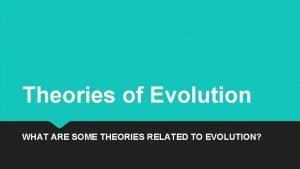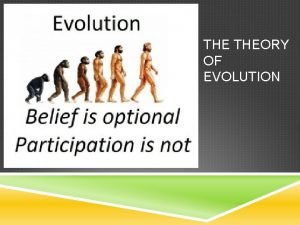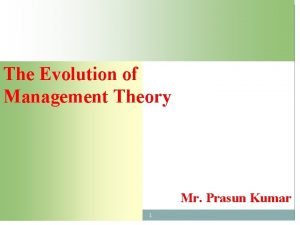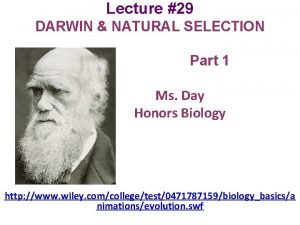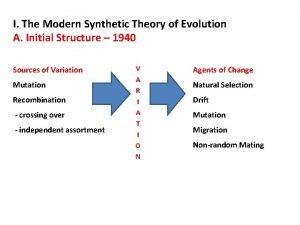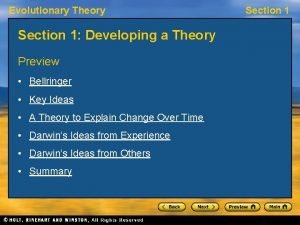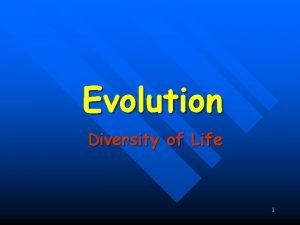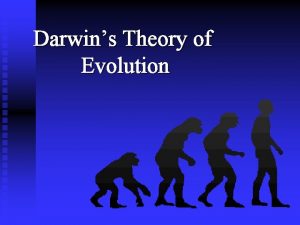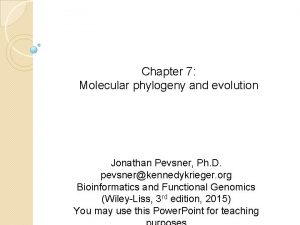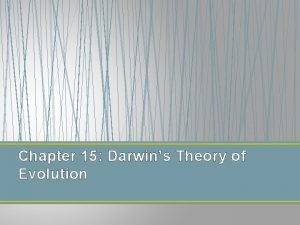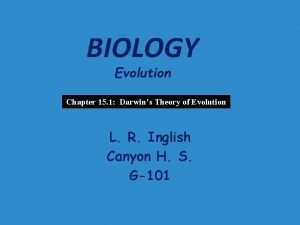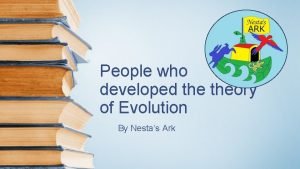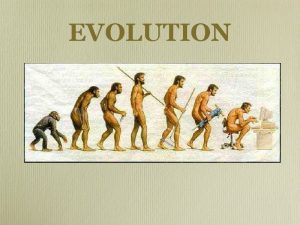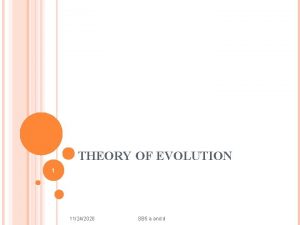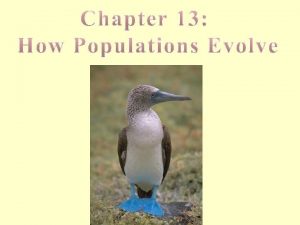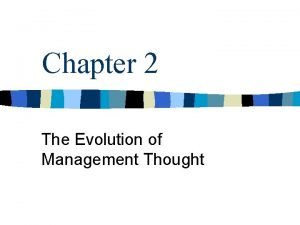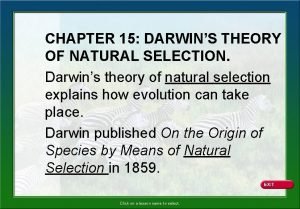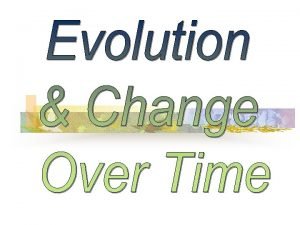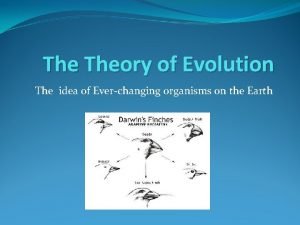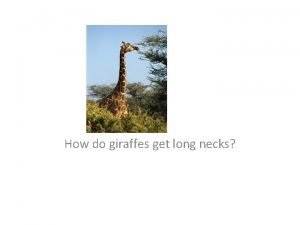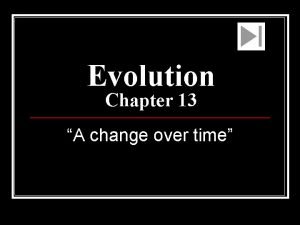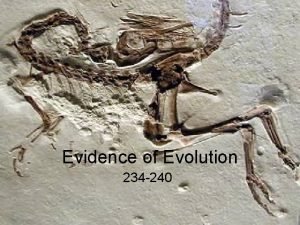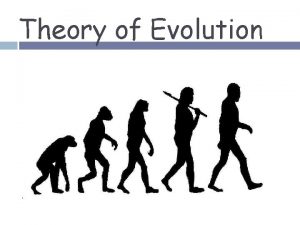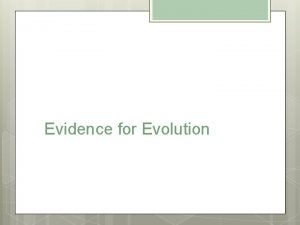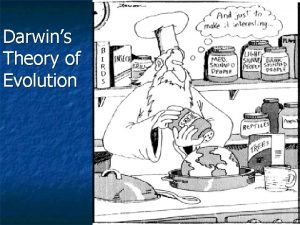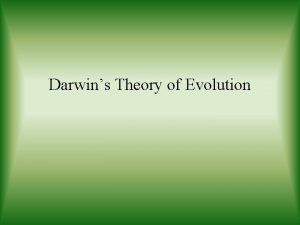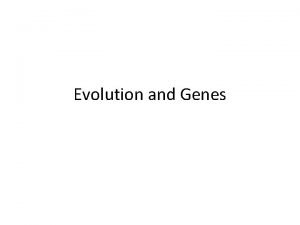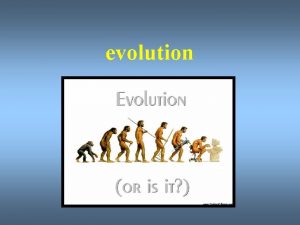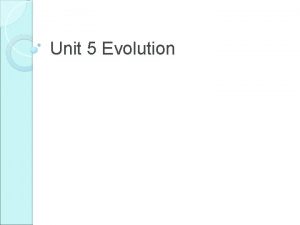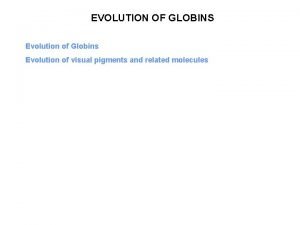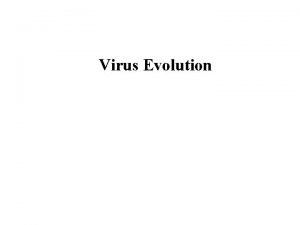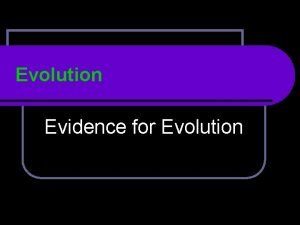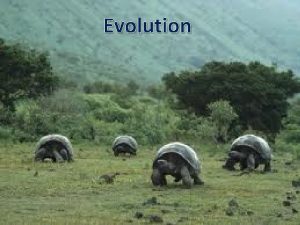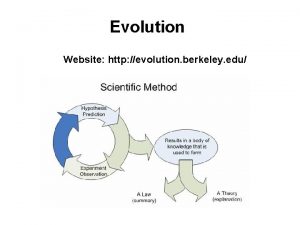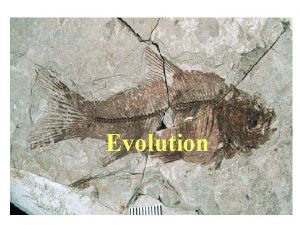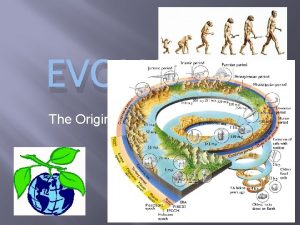I Theory of Evolution A Overview 1 Theory


























- Slides: 26


I. Theory of Evolution A. Overview 1. "Theory vs. Scientific Theory" a. "Theory" in everyday language is a guess b. "Scientific Theory" is supported by a large amount of evidence. An explanation of observations. 2. Definition of Evolution -- Change in a population over time a. The smallest unit that can change is a population. b. An organism does not evolve, a population does.

B. Lamarck: French naturalist, published his hypothesis in 1809. 1. Who was he? (a few fun facts) a. Frenchman b. [1744 -1829] c. Soldier in the French army…injury made him leave d. Botanist who lived in poverty e. Appointed professor of natural history of insects and worms (knew nothing about these things) f. Coined the term “invertebrate”

2. Lamarck’s Theory is based on his observations a. He observed that blacksmiths had big muscles and that family members stayed in the profession. b. organisms constantly strive to improve self and become more advanced. c. effort to improve causes the most used body structures to develop while the unused body structures wasted away (Use Disuse theory) d. the modification due to use or disuse is passed on to offspring (Inheritance of Acquired Characteristics) e. Another example he used is giraffes necks

3. Weismann (1889): Proves Lamarck wrong a. cut off the tails of mice for 22 generations. b. All offspring were born with tails. c. He concluded that changes in the body during your life are not passed down to offspring. (we know this now through genetics)

C. Charles Darwin 1. growing up years 2. education 3. Voyage of the Beagle (1831 -1836) a. purpose of the voyage was to make maps of coast of South America b. Darwin’s purpose was to make geological studies to locate minerals for mining…he was also the ships naturalist. c. Darwin observed plants and animals every time they docked. d. He noticed slight differences in them based on where they were e. He collected fossils and made notes about where he found them.


4. Visit to the Galapagos Islands during his voyage a. Local Finches (a type of bird) had different types of beaks based on what they ate b. Tortoises had different shells based on what island they were on c. Why were they different? How did they get that way?

5. Darwin’s Theory was influenced by 3 people a. Charles Lyell – wrote a book explaining that changes in the Earth were slow and uniform Darwin – slow Earth changes could affect plants and animals b. Thomas Malthus – observed that the human population was growing so fast that the supply of resources would not be able to support the population Darwin – There was always competition for food, space, and mates. Those that “win” survive and reproduce. c. Pigeon and Dog Breeders – select animals with the best traits to get the desired pigeon or dog Darwin – thought this process would naturally occur, but slower.

6. Darwin’s Theory of how evolution has occurred: Natural Selection a. There is a variety within a population b. Some traits are an advantage to have (they improve the organisms chance to reproduce) c. More young are created than the environment can support d. Those that survive and reproduce are those with the traits that are an advantage to have e. Over a long time, small changes accumulate and the population changes. 7. Darwin did not publish his theory for more than 20 years. He published On the Origin of Species in 1859.

II. Evidence of Evolution A. Study of fossils provides strong evidence for evolution 1. Paleontologist 2. Fossil Record – the sequence in which fossils appear within layers of sedimentary rocks a. sedimentary rocks form from layers of sand mud that settle to the bottom of seas, lakes and swamps. b. rock forms strata – layers of sedimentation. Younger ones are on top, older at the bottom. 3. relative dating of fossils = how old fossils are in relation to one another (younger fossils are located on top of older fossils) 4. absolute dating of fossils = exact age of fossils using radioactive elements a. Half-life = amount of time required for one-half of a sample of radioactive mineral to change into another substance


B. Biogeography = geographical distribution of species 1. Darwin saw that organisms on islands with similar environments in different parts of the world, resemble organisms on the mainland close to them instead of organisms on the island a. Continental island = island that at one time was attached to the mainland b. Volcanic island = island made from volcanic eruptions (Hawaii and Galapagos Islands) fewer species than continental no native mammals except bats no amphibians large portion of species are endemic = occur nowhere else in the world

C. Comparative Anatomy 1. Homologous structures = similarity in structure because they evolved from a common ancestor (functions may be different) 2. Analogous structures = similarity in function, but a different structure. a. wings of insects and wings of birds b. used as evidence to show evolution of ancestors adapting to similar environmental conditions = convergent evolution 3. Vestigial structures = structures of marginal, if any, importance. a. historical remnants of structures that were important in ancestors b. represent changes in an organism’s embryonic development brought about by natural selection

Homologous Structures

D. Comparative Embryology 1. Ontogeny = development of an individual 2. Phylogeny = evolutionary history of a species 3. “Ontogeny recapitulates phylogeny” = development of an individual is a replay of its evolutionary history a. similarities in embryonic development suggests evolution from a common ancestor b. in order to develop certain structures in the womb, they have to have the genes to do so 4. All vertebrate embryos have gill pouches and gill arches, and fish-like circulatory system (therefore they must have similar genes to develop these)

Human embryo Chick embryo

E. Molecular Biology 1. Similarities in Proteins a. Degree of similarity among amino acid sequence corresponds to relatedness b. Evolutionary relationships between humans and 5 other vertebrates based on hemoglobin comparisons shown in chart below. 2. Similarities in r. RNA 3. Similarities in noncoding sequences a. thought of as “fossil DNA”

III. The evolution of populations A. Populations are the units of evolution (not an individual organism) 1. Population – group of individuals of the same species living in the same place at the same time that can interbreed and produce viable offspring. 2. Biologists focus on the gene pool = total collection of genes in a population at any one time. a. alleles in all the individuals making up a population b. Microevolution = when the relative frequencies of alleles in a population change over a number of generations B. How does a population get genetic variation? 1. Crossing over 2. Independent assortment 3. Sexual reproduction 4. Mutation

C. How do you know if a population is evolving? 1. Hardy-Weinberg Theorem – developed in 1908 a. Mathematical model to show change in gene frequencies within a population, over time. b. Used to calculate the frequencies of possible genotypes future generations. basic equation: p+q=1 p = % dominant allele q = % recessive allele expanded equation: (p + q)2 = (1)2 p 2 + 2 pq + q 2 = 1 genotypes p 2 = homozygous dominant 2 pq = heterozygous q 2 = homozygous recessive in

2. If a population is not evolving, then the frequencies of genes and genotypes will remain the same through the generations a. the population is at “equilibrium” 3. In order for equilibrium to be possible, the following 5 things must occur. a. the population is extremely large b. it must be isolated from other populations c. no net mutations occur d. random mating must occur (no sexual selection) e. no natural selection occurs 4. The HW equation is used as a baseline--if frequencies deviate from HW values, then the population is evolving a. population still evolves even if at one gene loci 5. Microevolution is caused by violations of the 5 HW assumptions.

Example HW Problem: You have sampled a population in which you know that the percentage of the homozygous recessive genotype (aa) is 36%. Using that 36%, calculate the following: A. the frequency of the “aa” genotype B. The frequency of the “a” allele C. The frequency of the “A” allele D. The frequencies of the genotypes “AA” and “Aa” E. The frequencies of the two possible phenotypes if “A” is completely dominant over “a”.

Example HW Problem: There are 100 students in a class. Ninety-six did well in the course whereas four blew it and received a grade of F. Sorry. In the highly unlikely event that these traits are genetic rather than environmental, if these traits involve dominant and recessive alleles, and if the four (4%) represent the frequency of the homozygous recessive condition, please calculate the following: A. The frequency of the recessive allele B. The frequency of the dominant allele C. The frequency of the heterozygous individuals.

D. Mechanisms of Microevolution 1. Genetic drift = change in gene pool of a small population due to chance. a. Bottleneck effect = genetic drift resulting from an event that drastically reduces population size b. Founder effect = random change in the gene pool that occurs in a small colony of a population Example: “Founding population” of an island

2. Gene flow = gain or loss of alleles from a population by the movement of individuals or gametes a. migration of individuals into (immigration) or out of (emigration) an area. b. plant pollen 3. Mutation = random change in an organism’s DNA that creates a new allele a. raw material for evolution 4. Nonrandom mating = selecting mates (“sexual selection”) rather than by chance 5. Natural Selection = differential success in reproduction

E. Natural Selection can alter variation in a population in 3 ways 1. Stabilizing selection favors intermediate phenotypes. 2. Directional selection shifts the overall makeup of the population by acting against individuals at one of the phenotypic extremes. 3. Disruptive selection occurs when environmental conditions are varied in a way that favors individuals at both extremes of a phenotypic range.
 Lamarck's theory of evolution
Lamarck's theory of evolution Developmental homologies
Developmental homologies Evolution of management theory
Evolution of management theory Lamarck’s theory of evolution.
Lamarck’s theory of evolution. Synthetic theory
Synthetic theory Modern evolution theory
Modern evolution theory Lamarck’s theory of evolution.
Lamarck’s theory of evolution. Lamarck's theory of evolution
Lamarck's theory of evolution Strengths and weaknesses of evolutionary theory page 386
Strengths and weaknesses of evolutionary theory page 386 Neutral theory of molecular evolution notes
Neutral theory of molecular evolution notes Chapter 17 darwins theory of evolution
Chapter 17 darwins theory of evolution Section 3 other mechanisms of evolution
Section 3 other mechanisms of evolution Chapter 15 darwin's theory of evolution section review 15-1
Chapter 15 darwin's theory of evolution section review 15-1 Homologous structures definition biology
Homologous structures definition biology Explain the theory of evolution
Explain the theory of evolution Theory of natural selection
Theory of natural selection Lamarck theory of evolution notes
Lamarck theory of evolution notes Theory of evolution
Theory of evolution Theory of evolution
Theory of evolution Evolution of management thoughts
Evolution of management thoughts Chapter 15 darwin's theory of evolution
Chapter 15 darwin's theory of evolution Homologous structures example
Homologous structures example Law of natural selection
Law of natural selection Lamarck theory of evolution notes
Lamarck theory of evolution notes Endosymbiont theory
Endosymbiont theory Convergent evolution
Convergent evolution The theory that evolution occurs slowly but steadily
The theory that evolution occurs slowly but steadily
